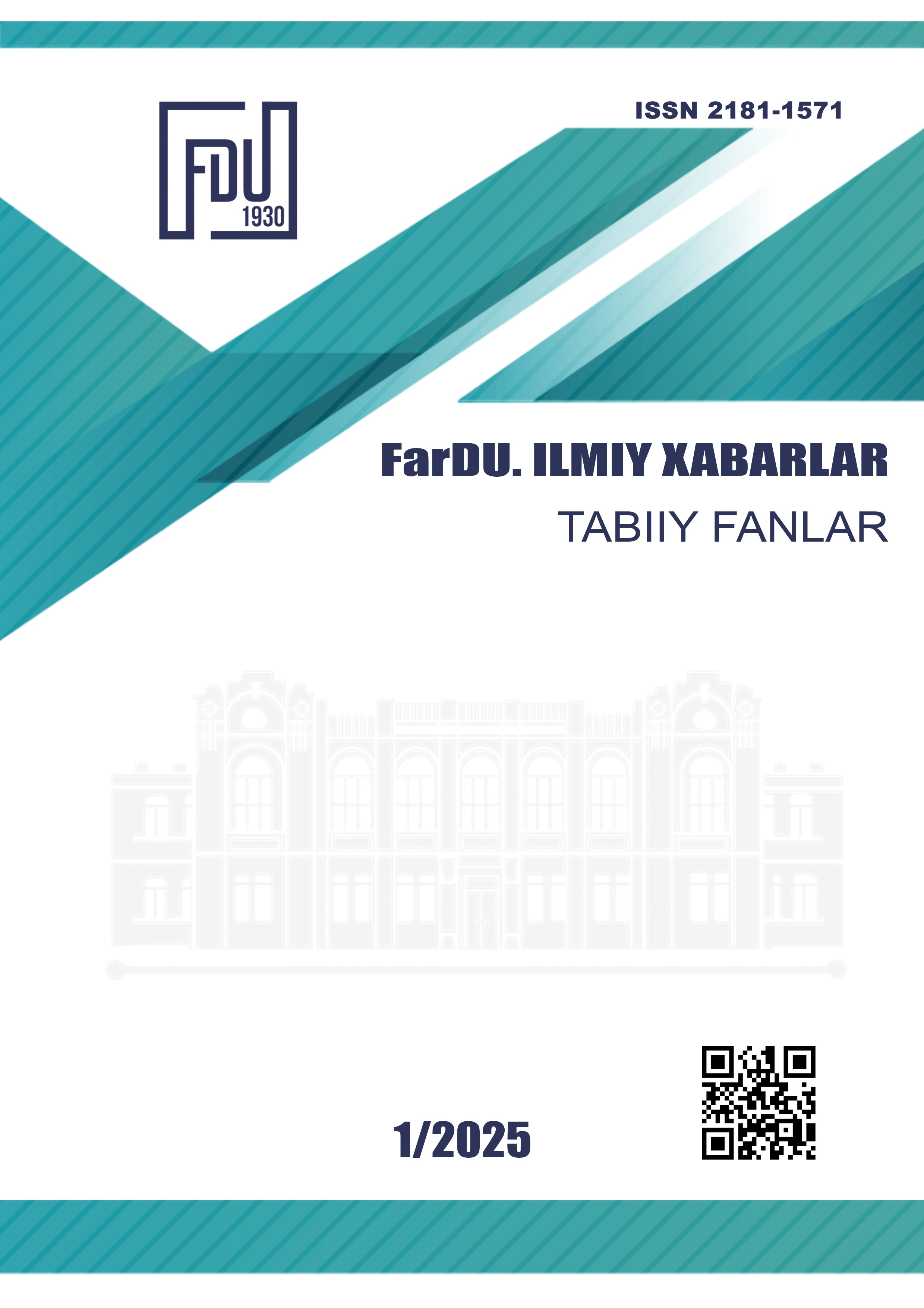STUDYING THE CHEMICAL CONSTITUENTS OF THE ESSENTIAL OIL FROM HORSERADISHLEAVES
Keywords:
Armoracia rusticana, horseradish, leaves, hydrodistillation, essential oil, GС-MS, 3-butenenitrileAbstract
The composition of the essential oil of dry horseradish leaves grown in the Fergana region was studied using gas chromatography-mass spectrometry. According to the results of the study, 21 compounds were found in the essential oil of horseradish leaves, of which 15 compounds were identified, which makes up 94.58% of the total number of detected compounds. The essential oil contains nitriles, heterocyclic compounds, unsaturated hydrocarbons, aldehydes, and terpenoids. The main compounds of the essential oil are 3-butenenitrile (48.3%); 10-methyl-9-nonadecene (13.40%); (2R, 4S)-2,4-dimethyl-5-hexen-1-ol (9.95%); phenylacetaldehyde (4.6%); 1-(5(methyl-2-furanyl)-1-buten-3-one (3.6%); 1H-pyrrole (2.2%) and (-)-isocaryophyllene (2.1%) were found.
References
Govaerts, R. (1995). World Checklist of Seed Plants 1(1, 2): 1-483, 529. MIM, Deurne.
Jiang Z.T., Li R., Yu J.C. (2006) Pungent components from thioglucosides in Armoracia rusticana grown in China, obtained by enzymatic hydrolysis. Food Technol Biotechnol. 44(1):41–45.
Bones A.M., Rossiter J.T. (2006) The enzymic and chemically induced decomposition of glucosinolates. Phytochemistry. 67(11):1053–1067.
Blazevic I., Mastelic J. (2009) Glucosinolate degradation products and other bound and free volatiles in the leaves and roots of radish (Raphanus sativus L.). Food Chem. 113:96–102.
Grob K., Matile P.H. (1980) Capillary GC of glucosinolate-derived horseradish constituents. Phytochemistry. 19(8):1789–1793.
Li X., Kushad M.M. (2004) Correlation of glucosinolate content to myrosinase activity in horseradish (Armoracia rusticana). J Agric Food Chem. 52:6950–6955.
Agneta R., Rivelli A.R., Ventrella E., Lelario F., Sarli G., Bufo S.A. (2012) Investigation of glucosinolate profile and qualitative aspects in sprouts and roots of horseradish (Armoracia rusticana) using LC-ESI - hybrid linear ion trap with Fourier transform ion cyclotron resonance mass spectrometry and infrared multiphoton dissociation. J Agric Food Chem. 60(30):7474–7482.
Bentivenga, G.,D’Auria M., Mauriello G., Raciotti R. (2004) SPME-GC-MSanalysis of horseradish (Armoracia rusticana). Ital J Food Sci. 4(16):487–490.
Petrovic S., Drobac M., Ušjak L., Filipovic V., Milenkovic M., Niketic M.(2017) Volatiles of roots of wild-growing and cultivatedArmoracia macrocarpa and their antimicrobial activity, in comparison to horseradish, A. rusticana. Ind. Crops Prod. 109: 398–403.
Ren J.J., Zhang D.,Hou P.X., Wu H.(2020) Effects of horseradish oil (Armoracia rusticana) and eight isothiocyanates vapour treatment on the postharvest disease control and their efficacy as preservatives of mature green tomato. Plant. Dis. 104: 2688–2695.
Tomsone, L., Galoburda, R., Kruma, Z., Cinkmanis, I. (2020) Characterization of dried horseradish leaves pomace: phenolic compounds profile and antioxidant capacity, content of organic acids, pigments and volatile compounds.Eur Food Res Technol. 246, 1647–1660.
Downloads
Published
Issue
Section
License
Copyright (c) 2025 Scientific journal of the Fergana State University

This work is licensed under a Creative Commons Attribution-NonCommercial-NoDerivatives 4.0 International License.
Most read articles by the same author(s)
- Ozoda Xalimova, Azamjon Xusanov, VOICE DISORDERS TYPES OF VOICE DISORDERS AND CAUSES , Scientific journal of the Fergana State University: No. 1 (2023): Scientific journal of the Fergana State University (Exact and natural sciences)
- Ozoda Yadgarova, PROJECTIVE METHODS IN PERSONAL STUDY ANALYSIS OF ADVANTAGES , Scientific journal of the Fergana State University: No. 1 (2023): Scientific journal of the Fergana State University (Exact and natural sciences)
- , ABOUT THE CONCEPT OF «TRANSLATION CENTERS OF MEDIEVAL EUROPE» AND IT’S SCHOLARLY USE , Scientific journal of the Fergana State University: No. 5 (2022): Scientific journal of the Fergana State University
- , THE LAND OWNERSHIP SYSTEM AND ITS SPECIFIC ASPECTS IN THE KINGDOM OF XIV AT THE END OF THE XIX CENTURY AND THE BEGINNING OF THE XX CENTURY , Scientific journal of the Fergana State University: No. 1 (2024): Scientific journal of the Fergana State University (Social humanities sciences)
- , ANALYSIS OF SOCIO-PHILOSOPHICAL RESEARCH DURING THE PERIOD OF INDEPENDENCE (1990-1994) , Scientific journal of the Fergana State University: No. 1 (2024): FarDU.Ilmiy xabarlar jurnali (Aniq va tabiiy fanlar)
- , , , STUDYING THE MACRO AND MICROELEMENT COMPOSITION OF LOCAL WINE PRODUCTS , Scientific journal of the Fergana State University: No. 4 (2024): FarDU.Ilmiy xabarlar jurnali (Aniq va tabiiy fanlar)
- , , , INVESTIGATION OF THE ELEMENTAL COMPOSITION OF THE PLANT PRUNUS CERASUS L. BY ICP-MS. , Scientific journal of the Fergana State University: No. 2 (2023): Scientific journal of the Fergana State University (Exact and natural sciences)
- Xikmatillo Abdikunduzov , Alidjon Ibragimov , Otabek Nazarov , Iqboljon Jalolov , Elyor Akbarov , DETERMINATION OF THE QUALITY AND QUANTITY COMPOSITION OF FLAVONOIDS IN THE LEAVES OF GRAPE (Vitis vinifera) VARIETY PINOT NOIR , Scientific journal of the Fergana State University: No. 1 (2022): Scientific journal of the Fergana State University
- , , , DETERMINATION OF FABRICS COLOR FASTNESS, SWEAT RESISTANCE AND COLOR FADING RESISTANCE , Scientific journal of the Fergana State University: No. 3 (2024): FarDU.Ilmiy xabarlar jurnali. Ilova to'plam (Aniq va tabiiy fanlar)
- , , STUDY OF MINERAL AND FLAVONOID COMPOSITION OF POMEGRANATE FRUIT , Scientific journal of the Fergana State University: No. 6 (2024): FarDU.Ilmiy xabarlar jurnali (Aniq va tabiiy fanlar)

